How Will the Future of AI Compressing Text Visually Change Our Reception of Information?
The evolution of artificial intelligence is impacting our daily lives more and more. A new AI model announced by DeepSeek incorporates a unique method of compressing text using visual perception. How will our reception of information change once this technology becomes widespread?
1. Today’s News
Source:
SCMP Article
Summary:
- DeepSeek has announced a new AI model that compresses text using visual perception.
- This AI model allows for processing complex documents with fewer tokens.
- The model is open source and available on developer platforms.
2. Considering the Background
As the information society evolves, efficiently processing vast amounts of data poses a significant challenge. In past text processing, large quantities of information often resulted in slower processing times. This new AI technology offers a method to process information efficiently with a lesser quantity of data by leveraging visual information. This evolution could significantly impact how we receive information in our daily lives.
3. What Does the Future Hold?
Hypothesis 1 (Neutral): A Future Where Visual Information Processing Becomes Standard
Visual information processing may become commonplace, allowing our devices to process data more efficiently. This would enable applications and services we use daily to operate more smoothly, allowing us to access information without stress. As our way of receiving information changes, our values may also evolve towards acquiring information “quickly” and “efficiently.”
Hypothesis 2 (Optimistic): A Future of Significant Advances in Information Processing Technology
As this technology evolves, the capacity for information processing will dramatically improve, leading to applications in various fields. In education, healthcare, and business settings, it will become possible to analyze information instantly and make optimal suggestions. The quality and quantity of information may improve significantly, enriching and making our lives more efficient.
Hypothesis 3 (Pessimistic): A Future Where the Quality of Information Deteriorates
Conversely, if information compression becomes too advanced, the quality of information could decline, making it harder to convey original meanings. Relying on visual information may cause us to lose the fine nuances of text. As a result, we may only perceive the surface aspects of information, making deep understanding difficult.
4. Tips We Can Use
Thought Process Tips
- When receiving information, it’s essential to question your values and understanding.
- Consider how to utilize new technologies in your daily choices.
Small Practical Tips
- Develop a habit of questioning and thinking deeply when obtaining information.
- Increase opportunities to discuss new technologies and share knowledge.
5. What Would You Do?
- Would you consider ways to strengthen your judgment without becoming overly dependent on technology?
- Would you actively use AI technology to make your life more efficient?
- Would you emphasize the quality of information and strive to adopt a multifaceted perspective on information?
What kind of future do you envision? Please share with us through social media quotes or comments.









